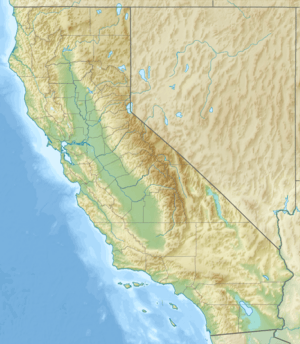Mavericks, California facts for kids
Quick facts for kids Mavericks |
|
|---|---|

4-frame image that shows the famous break of Mavericks
|
|
| Location | Pillar Point Harbor, California |
| Coordinates | 37°29′29″N 122°30′30″W / 37.49149°N 122.508338°W |
| Geology | Surf break |
Mavericks is a world-famous surfing spot in northern California. It's found just outside Pillar Point Harbor, near the town of Half Moon Bay. During strong winter storms in the Pacific Ocean, waves at Mavericks can often reach over 25 feet (7.6 meters) high. Some waves can even top out at over 60 feet (18 meters)! These huge waves are so powerful that they can sometimes be recorded by special machines called seismometers, which usually detect earthquakes. The reason for these giant waves is a unique rock formation hidden under the water.
Mavericks is a popular winter spot for some of the world's best big wave surfers. For many years, a special contest called the Titans of Mavericks was held here. Only invited surfers could compete, and it only happened when the waves were just right.
Contents
How Mavericks Got Its Name
In March 1967, three friends named Alex Matienzo, Jim Thompson, and Dick Notmeyer went surfing near Pillar Point. Alex brought his roommate's white-haired German Shepherd dog, Maverick. This dog loved to swim with them while they surfed.
The surfers left Maverick on the shore, but he swam out to join them! Alex realized it was too dangerous for the dog in the big waves. He tied Maverick up before going back to his friends. The surfers didn't have much luck that day. They rode some waves about a quarter of a mile (400 meters) from shore. They thought the really big waves further out were too risky. They decided to name the surfing spot after Maverick, the dog who seemed to have the most fun that day!
What Makes Mavericks Waves So Big?
Scientists used maps of the sea floor to understand Mavericks' giant waves. These maps, released in 2007, showed a long, sloping ramp under the water.
The Sea Floor's Secret
As a wave travels over this underwater ramp, it slows down. But the parts of the wave over the deeper areas on each side of the ramp keep moving fast. This difference in speed creates a U-shaped or V-shaped wave. All the wave's energy from a wide area gets squeezed into a small spot at the top center of the ramp. This causes the wave to break with incredible force.
The "Left Hander" Wave
Mavericks has a "left" wave, but surfers rarely ride it. This wave is often unreliable and can be much faster than the main "right" wave. It can create a quick, hollow tube for surfers. Some describe it as "a short-lived explosion of hell and spitfire."
History of Mavericks Surfing
Jeff Clark grew up watching Mavericks from his high school in Half Moon Bay. Back then, people thought the waves were too dangerous to surf. But Jeff dreamed of riding Hawaii-sized waves right there in California.
In 1975, when he was 17, Jeff paddled out alone. The waves were 20 to 24 feet (6 to 7.3 meters) high. He became the first person known to successfully surf Mavericks.
Mavericks Becomes Famous
For a while, only a few of Jeff's friends believed in Mavericks. Many big wave surfers thought California didn't have such huge waves. But then, in 1990, a photo of Mavericks taken by Jeff's friend Steve Tadin appeared in Surfer magazine. This photo sparked a lot of interest.
More pictures of Mavericks were published, and a filmmaker named Gary Medeiros released a movie about it. As news spread, many big-wave surfers came to experience Mavericks for themselves.
Safety at Mavericks
Surfing big waves like Mavericks is very dangerous. Over the years, there have been tragic accidents that led to important safety changes.
In 1994, a well-known Hawaiian surfer named Mark Foo had a serious accident at Mavericks. This event made the surfing community realize the need for better safety. As a result, the Mavericks Water Patrol was created to help surfers in trouble. The accident also started a big discussion about using surfboard leashes safely. Some surfers believe leashes can be dangerous in huge waves, while others say they are helpful. Today, many surfers use quick-release leashes that can be easily detached if needed.
In 2011, another experienced big-wave surfer, Sion Milosky, also had a tragic accident at Mavericks. These events remind everyone of the extreme risks involved in big wave surfing and the importance of safety measures.
Women Surfing at Mavericks
In 1999, Sarah Gerhardt made history by becoming the first woman to surf Mavericks. For many years, women were not included in the main surfing competition. But after a long effort, in 2018, women were finally included in the Titans of Mavericks contest. They also received the same prize money as the men, which was a big step for equality in surfing.
The Mavericks Surfing Contest
The first surfing contest at Mavericks was held in 1999. It was called the Mavericks Invitational and later became known as the Titans of Mavericks invitational. Only a select group of big wave surfers were invited to compete. The contest only happened on one day during the winter season (November 1 to March 31) when the waves were perfect.
However, the competition faced many challenges. After two years of being canceled, the World Surf League announced in 2019 that the contest was canceled for good. It has not been held since.
Today, there's a new way to celebrate Mavericks' waves called the Mavericks Awards. This is a video contest where surfers and videographers submit their best footage from Mavericks each season. There are different categories for men and women, including "Biggest Wave," "Ride of the Year," and "Performer of the Year."
See also
- List of surfing records








